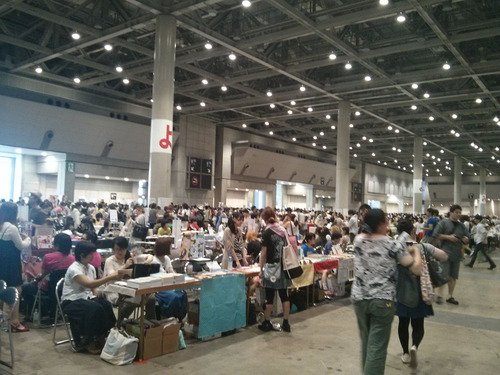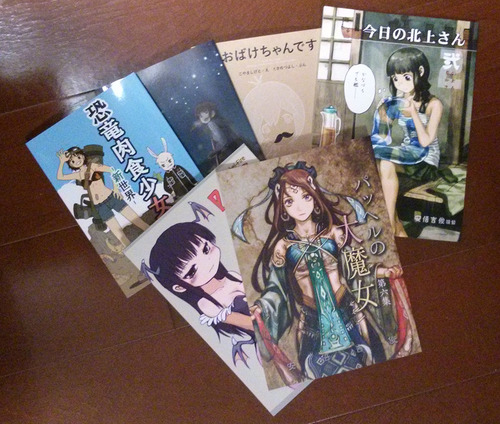Last weekend, I spent a few hours at the famous Comic Market. It’s a huge, confusing event, but it can be a lot of fun, so I decided to write up a little post about what I know, so you can skip some of the figuring-it-out stage if you intend to visit, or just imagine you were there.
Comic Market, abbreviated Comiket or コミケin Japanese, is Japan’s biggest comic convention. Calling it a convention, however, might create some confusion for people who are familiar with American or European comic cons… There is no big, elaborate publisher booths, panels, or signings with creators.
In fact, the japanese term for this type of event is 即売会, which loosely translates into “on-the-spot sale meet.”
In fact, the japanese term for this type of event is 即売会, which loosely translates into “on-the-spot sale meet.”
The entire event is essentially what is known at conventions outside Japan as artist’s alley. Exhibitors attend it mainly to sell their doujinshi, amongst some other goods and apparel.
A doujinshi sold at Comiket can be anything from a few copies stapled together, to full blown artbooks, but the vast majority are leaflets of about 30 pages or so, with a full color cover and black & white inside pages, in A5 or B5 size.
This is my haul from Sunday. The small (A5) books in the upper left, which amazingly have about 80 pages, cost 400 yen, or about $4. The bigger (B5) ones with about 30 pages were still only 500, and the one in the top right, which has full-color insides, was 1,000 Yen. These B5 books are from Serial Experiments Lain and Haibane Renmei creator ABe Yoshitoshi, some samples from the insides are up on his Pixiv account if you want to check them out.
There’s a lot of on-demand printing services that are very easy to use and dirt cheap. Depending on the paper quality and amount of copies you produce, it’s entirely possible to make a beautiful 30+ page book for not much more than 100 Yen per book.
Some relatively unknown creators I talked to mentioned they had done a print run of about 200 copies, while superstar creator Akamatsu Ken of Love Hina and Negima! fame mentioned selling about 8,000 copies before 1pm.
Comiket is held at Tokyo Big Sight, a huge convention hall with an exhibition space of 80,660 square meters (868,217 square foot) For comparison, the dealer floor at San Diego Comic-Con is 460,000 square feet = 42,700sqm. It’s held twice a year, typically in August and December
This year’s summer Comiket claims to have had 550,000 visitors. I’m not entirely sure how they count that, since there are no tickets (just gigantic open gates), and rumor has it they keep the numbers artificially low to avoid problems with fire protection law and the like. Either way, it was a madhouse.
An official report said there were over 10,000 people camped out overnight for the first day this year.
An official report said there were over 10,000 people camped out overnight for the first day this year.
But of course it wouldn’t be a convention without exhibitors – this year, the official Comiket publicity twitter account reported around 35,000 circles were attending. That’s mindblowing, considering that the chance for winning the attendance lottery is supposed to be around 50-70%.
What’s a circle, you ask? Circle, in this context, refers to a group of people who share a passion for a subject (such as an anime series or a videogame), enough to band together and produce doujinshi together.
As you might have heard, the term doujinshi, spelled 同人誌 in Japanese, literally translates into “same people magazine.” For years, I just assumed that this referred to a book featuring characters from an established property (thus the “same people”). But then I found out that there’s lots and lots of original properties being told in the same format, and they’re also called doujinshi. So I put the question to Twitter, and one of my Japanese acquaintances explained that the “same people” doesn’t refer to the characters, but the people comprising the circle, who share the same interests. Mind blown!

Each booth, or “space” as it’s called at Comiket, comes with a narrow table, and two chairs. Most exhibitors do little to spice up their booth, some add a table cloth, maybe a little standee banner, but nothing too fancy. Obviously, the books are the main attraction here.
There is very little aggressive selling. Very few people will ask you to take a look at their books, and asking someone to buy is actively discouraged.
Which brings up the question, how the hell do you find anything in this huge place, when there’s so little clues?
Obviously it’s easier if you know a creator that you want to go visit. They’ll have announcement up on their blogs, Twitter, or Pixiv (the Japanese equivalent of Deviantart). A lot will even change their Twitter handle to include the booth number, like so: 安倍吉俊/3日目東A41a,b “Abe Yoshitoshi, 3rd day, East A41a,b.” So Abe Yoshitoshi can be found on the 3rd day of the event, in the East hall, A41 a and b. Note that while the event is 3 days, each circle is only represented on one of them.
What if you’re not looking for a specific creator, but a genre, for example, say, a Naruto fanbook? The halls are divided by genre, 42 rough categories, and similar books will usually be grouped together. The category for Naruto and other Shounen Jump books will be FC(少年).
So you know the category now, and if you’re only there for one category you might as well just go to that area of the event and browse. But say you want to narrow it down a little more. There is a catalog available before the event, sold at book- and anime stores etc. for about 2000 Yen. As you can probably imagine from having seen manga magazines, the catalog is pretty close in dimensions to a phone book. And the insides look like this:

Yeesh. This is a page in the Kancolle section, featuring doujinshi of the popular character Shimakaze. It has the row number (ソ, note that there will be alphabet, hiragana and katakana row numbers), and then a single image for every circle to present their visual style, with the booth number and circle name. That’s all the hints you get. If you find one that piques your interest, it can’t hurt googling the name and see if they have a twitter or Pixiv account which might feature some more samples of their work.
It’s a pretty daunting task.
Here’s a look at one of the halls’ floor plans:

Notice how the “A” section is hugging the walls, with a broad-ish corridor between it and the rest of the tables? This is where the bigger, well-known circles get to exhibit. They tend to draw larger crowds, so they are positioned in ares where they can form lines (which usually extend out of the huge gates) without blocking the other exhibitors’ booths. The ends of the rows are similar, as they also offer more space and a clearer view of the booth.
As you can imagine, a lot of the Shimakaze books on the catalog page above are adult books, which is something that doujinshi are very commonly associated with. And rightly so, this is definitely a big part of Comiket’s wares.
But there is so much more to be found. Obviously there are other, non-adult themed fanfiction doujinshi, but there is also a ton of other content. A small list of things I discovered in my very cursory browsing of this year’s Comiket, after I was done checking out the creators I had planned in advance, directly from my twitter updates:
Travel essays, train photos, anti-TPP propaganda leaflets, screenplays… this is #comiket too. UFO magazines. Tons of them for the believers. Restaurant review booklets. Recipe collections. Flute playing instructions. Stickers. Charms. Papercraft. Handmade dolls. Handmade bags, purses and earrings. T-shirts. Rubber stamps.
The above is from a span of about 20 minutes of my tweets. There is a vast amount of content to be found for all tastes, if you manage to find it in the limited amount of time available: Comiket opens at 10 and closes at 4pm. As I mentioned above, over 10,000 people spend the night in the parking lot overnight and flood the venue all at once, so even entering before noon is literally impossible.
I usually try to be there about 12:30 – 1pm. The crowds are still absolutely crazy, but there’s no wait to actually enter the venue, and it’s possible to navigate without getting squashed. Popular books start selling out around 2-3pm, at which point the exhibitors pack up and go home, so some research into what you plan to look at is a must.
I usually try to be there about 12:30 – 1pm. The crowds are still absolutely crazy, but there’s no wait to actually enter the venue, and it’s possible to navigate without getting squashed. Popular books start selling out around 2-3pm, at which point the exhibitors pack up and go home, so some research into what you plan to look at is a must.
Also, there’s two areas of the event that I haven’t touched upon: The commercial booths and cosplay areas. The commercial booths, 企業ブース in Japanese, are put up by publishers, anime companies and apparel/goods vendors.

Unlike the publisher and TV booths at an american convention, there are no talkshows, meet-and-greets, or any activity other than sales here. All there is are limited edition goods (anything from printed tumblers to the notorious 抱き枕 – long pillows with a print of an anime character on them) to be bought, and people gladly line up for an hour to get to them. Honestly, even going up there isn’t worth it. There’s too many people, and very little to see.
The cosplay area(s), on the other hand, are a different story. There’s tons of really elaborate, great cosplay here, but the thing is that it’s separate from the dealer floor (aside from a select few people wandering around in costume, and a few aisles of cosplay photo books and DVDs being sold). The Comiket rules dictate that cosplayers need to change into their costumes on site (there are dressing rooms available), and cosplayers then pose for photographers in a roped-off area outside specifically reserved for that purpose. It’s huge, and there’s like 20 photographers with huge DSLRs crowding around each scantily clad girl, but I can tell you little else because I haven’t really bothered to go in myself. My understanding is that you actually have to get a permit on site to take pictures (a result of Japan’s rampant trend of taking unwanted pictures, and extreme protectiveness of ones portrait rights, and generally personal information). So I’ll leave that up to someone more in-the-know to describe.
That’s it! Pretty much all I know about Comiket! Let me know via Disqus or the Ask me feature in case there’s anything you want me to elaborate on. I’ll be happy to help!
(ported from my tumblr)




Pingback: Comiket Special 6 – Otaku Summit 2015 |